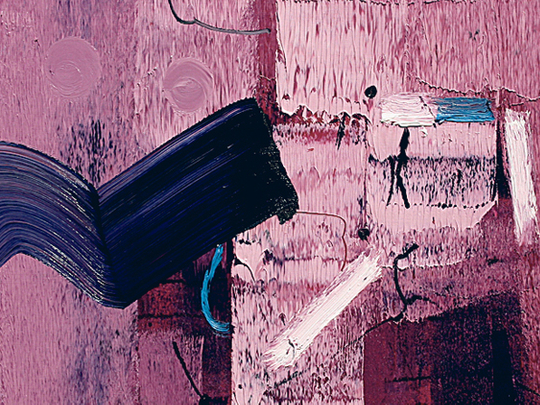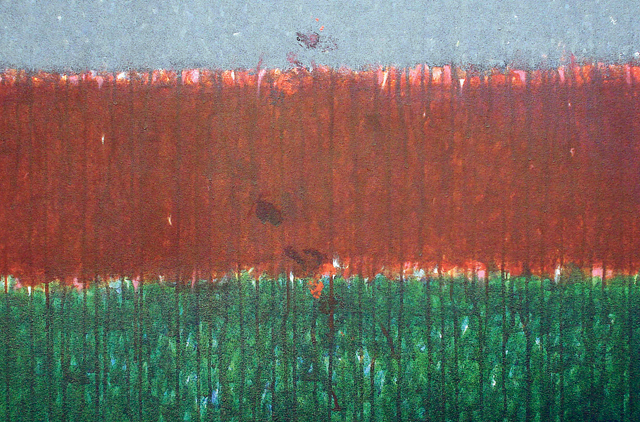
The Indo-Oman Art Exchange took place at the Al Nahda Resort and Spa, Barka, Oman, from February 16 to 23. The event featured nine artists from India and Oman working alongside each other, engaging in dialogue and making their works and their artistic processes accessible to visitors.
When Weekend Review went to the expo on the second day, the artists had begun their work. Watching the metamorphosis of an inchoate canvas into a finished one on the final day, February 23, was a fascinating experience.
Furthermore, the diverse artistic polyphony in the form of works by Omani and Indian artists presented a glimpse into each culture's particular visual language while reaffirming the strong cultural bonds that Oman and India have historically shared and continue to do.
"Holding an event such as this was a dream of mine ... and I am glad to see it coming to fruition," said Radhika Hamlai, who conceived, conceptualised and executed the project.
An accomplished abstract artist in her own right and dedicated to promoting arts in Oman, Hamlai emphasised that she felt the project was as educative for art lovers and the public of the country as for the artists themselves. "For me, education is a continuous process and it is imperative to constantly educate yourself about art," she said.
The group of Indian artists consisted of Amrut Patel, a renowned artist and a board member of the National Academy of Art, New Delhi; Gopi Gajwani, a well-known abstract painter; R.B. Bhaskaran, former chairman of the National Academy of Art, New Delhi; Suhas Nimbalkar, one of the founder members of the Spectrum group of Indore painters; and Hemraj, an acclaimed abstract artist — all active participants in shaping the identity of modern Indian art.
The workshop gave the distinguished group of Indian artists an opportunity to acquaint themselves and interact with leading figures of the Omani art scene.
The group from Oman consisted of Anwar Sonya, widely considered a pioneer in Omani art; Mariam Al Zedjali, director of the Omani Society for Fine Arts; Sarah White, arts adviser and curator at Bait Al Zubair museum and a notable artist who has also published the first book in English on Oman's contemporary art; and Hamlai herself.
The artists worked on two pieces each, which will be exhibited alongside four previous works of theirs at the Bait Muzna Gallery until March 22.
Each artist continued to articulate and develop within the ambit of their distinctive artistic language during the exchange. Since 2000, Patel has been primarily interested in evolving a visual language solely born out of colour and form. He favours transparent layering in acrylic, allowing the viewer to see the first and last layer — the simultaneous viewing of the beginning and ending. Nimbalkar spoke of his belief that the prime function of fine art was to provide a spiritual experience. "If a painting can be explained in words, why have a painting at all?" he said, emphasising that his work should, therefore, be a purely sensory experience. Al Zedjali talked about the interplay of experimenting with colours and constantly harking back to Oman's rich heritage — old doors, textiles, houses — in her work. White delved into the aesthetics involved in the beautification and adornment of the face, while Sonya explored the art of calligraphy, having earlier worked in abstract and video art.
Apart from expressing their individual artistic voices, the artists also embraced the opportunity that the exchange provided to discover, contemplate and participate in dialogue with each other and discuss their work.
"You can take a break from your work and see what the others are creating," said White, adding that it made a welcome change from her normal routine of working in isolation. Furthermore, every evening, one artist would provide a presentation of their work, delineating the processes involved in its creation.
"The spirit of imbibing and feeding off each other's creative energies clearly emerged from the artists' enthusiasm about working with each other, reflecting a camaraderie of sorts. "I have participated in many art camps before. But they were larger in scale and precluded the chance for the artists interacting with one another. Here the group was more compact and this broadened the scope of connecting with each other," Nimbalkar said.
For the Indian artists, it also meant becoming familiar with aspects of Omani visual language and redefining their earlier association with the Omani art scene.
"India is a continent in itself and we [the Indian artists] are from different parts of India. The exchange featured a cross-section of artists who have achieved prominence and allowed us all to partake of a true cultural and artistic exchange," Bhaskaran said. What clearly mattered to the artists was to become aware of and appreciate fellow artists' respective styles. "We are all communicating with each other in the language of art and that language needs no translation," Sonya said, encapsulating the essential spirit of the exchange.
The artists also welcomed visitors in their midst, finding their presence as stimulating. For example, they greatly enjoyed a visit by schoolchildren, responding to their queries about the creative process and thus enabling them to become a part of the very process itself.
"We appreciated it when people asked questions about our artistic process. We had to start thinking about what we had created," says Hamlai, adding that the visitor-artist interaction also enabled the artist to become accessible, rather than remain a shadowy, elusive figure. "The visitor can therefore be privy to the mind of the artist," Hemraj said.
For the viewer, the exchange therefore provided an insight into the way an artist physically built up his/her respective work and provided an exposition of the underlying creative forces contributing towards the development of a work. As the visitor was privy to the journey of a painting from beginning to culmination, the work was no longer a static entity. It was developing according to the artist's thoughts and the visitor's perceptions of it.
For example, White's striking images of made-up faces were richly hued and layered: There was an interesting parallel of painting a face heavily affected with macquillage and yet the face was a bare canvas of a kind prior to application of make-up, being readied to be painted into a different personality.
Hamlai's works were an explosion of colour, pattern and texture, while Sonya's monochrome calligraphy pieces spoke of a beautiful gravitas, a complete transformation from the barely worked upon canvas seen in the earlier stage. Similarly, Hemraj's midnight-blue and leaf-green hued works radiated the same freshness that they had done during the initial days of creation.
The last day saw the presence of art historian and curator Dr Alka Pande, consultant arts adviser and curator at the Visual Art Gallery of India Habitat Centre, New Delhi, and author of books such as Indian Art — The New International Sensation: A Collector's Handbook. Dr Pande lectured on the history and evolution of Indian art, before providing an informative commentary on collecting modern Indian art.
"I think the art exchange was wonderful, what with the tranquil surroundings and the literal exchange of art by artists working together through the day," she said. "It was not only an intense experience but also one of sharing."
Referring to the Indo-Omani collaboration, she commented that juxtapositions generally offer much food for thought, with the potential of not always working. "In this case, I think [it] provided interesting contrasts. The two groups of artists possessed a very different visual language and yet they also happened to share common traits. The marriage of both [common qualities] presented infinite possibilities of creative expressions in painting."
She also pointed out in her lecture the significance of India emerging as an exciting new player in the global art arena. She said that it would be equally interesting to see as to how Omani artists and their work would fit within the matrix of global art interest and commerce.
"Globalisation plays a key role in artistic expression, what with shrinking of geographical boundaries and technology redefining communication. Naturally, in times of homogeneity — itself a result of global cosmopolitanism — religion plays a more defining role in world cultures. For the Omani artists, the prevailing religious influences will imbue their work with a distinctive local flavour at a time when many artists are pushing away their regional identities and adopting a more universal language," she said.
However, Dr Pande felt that Oman too would have to negotiate its particular relationship with globalisation and ultimately have to locate and develop its own methodology of achieving its international voice.
The art exchange evidently functioned as an excellent introduction in regard to several aspects, whether it was the artists of two different cultures becoming acquainted with each other's works and visual languages or the visitor acquiring a window through which to peek at the artist at work.
Priyanka Sacheti is an independent writer based in Muscat.
The Indo-Oman Art Exchange exhibition is on at the Bait Muzna Gallery in Muscat, Oman, until March 22.












